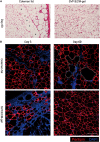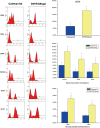Phenotypic and Cellular Characteristics of a Stromal Vascular Fraction/Extracellular Matrix Gel Prepared Using Mechanical Shear Force on Human Fat
- PMID: 33718340
- PMCID: PMC7952646
- DOI: 10.3389/fbioe.2021.638415
Phenotypic and Cellular Characteristics of a Stromal Vascular Fraction/Extracellular Matrix Gel Prepared Using Mechanical Shear Force on Human Fat
Abstract
The retention of fat-derived grafts remains a challenge for regenerative medicine. Fat aspirates from patients undergoing liposuction were prepared into standard Coleman fat grafts or further isolated using mechanical shear force to prepare a stromal vascular fraction (SVF)/extracellular matrix (ECM) gel. The retention rate of the SVF/ECM gel was significantly higher than that of the Coleman fat at 3, 14, 28, and 60 days following transplantation on the backs of nude mice. The viscosity of the fat was directly proportional to the shearing force. Although the mechanical isolation did not affect the total number of cells, it significantly decreased the number of living cells. Flow cytometry showed a greater number of mesenchymal stem cells, supra-adventitial (SA)-adipose stromal cells (ASCs), and adipose-derived stem cells but a lower number of endothelial progenitor cells in the SVF/ECM gel than in the Coleman fat. Thus, mechanical isolation of fat can increase the pluripotency of adipocytes, which can improve graft retention in cell therapy.
Keywords: Coleman fat; SVF/ECM gel; flow cytometry; shear force; stem cells; tissue regeneration.
Copyright © 2021 Ye, Zou, Tan, Hu and Jiang.
Conflict of interest statement
The authors declare that the research was conducted in the absence of any commercial or financial relationships that could be construed as a potential conflict of interest.
Figures








Similar articles
-
Comparison of stromal vascular fraction cell composition between Coleman fat and extracellular matrix/stromal vascular fraction gel.Adipocyte. 2024 Dec;13(1):2360037. doi: 10.1080/21623945.2024.2360037. Epub 2024 Jun 3. Adipocyte. 2024. PMID: 38829527 Free PMC article.
-
Mechanical force promotes tissue and molecular changes in adipose tissue regeneration post-transplantation.Front Cell Dev Biol. 2024 Sep 18;12:1472575. doi: 10.3389/fcell.2024.1472575. eCollection 2024. Front Cell Dev Biol. 2024. PMID: 39359720 Free PMC article.
-
Mechanical process prior to cryopreservation of lipoaspirates maintains extracellular matrix integrity and cell viability: evaluation of the retention and regenerative potential of cryopreserved fat-derived product after fat grafting.Stem Cell Res Ther. 2019 Sep 23;10(1):283. doi: 10.1186/s13287-019-1395-6. Stem Cell Res Ther. 2019. PMID: 31547884 Free PMC article.
-
Systematic Review: Allogenic Use of Stromal Vascular Fraction (SVF) and Decellularized Extracellular Matrices (ECM) as Advanced Therapy Medicinal Products (ATMP) in Tissue Regeneration.Int J Mol Sci. 2020 Jul 15;21(14):4982. doi: 10.3390/ijms21144982. Int J Mol Sci. 2020. PMID: 32679697 Free PMC article.
-
Augmentation of Dermal Wound Healing by Adipose Tissue-Derived Stromal Cells (ASC).Bioengineering (Basel). 2018 Oct 26;5(4):91. doi: 10.3390/bioengineering5040091. Bioengineering (Basel). 2018. PMID: 30373121 Free PMC article. Review.
Cited by
-
Comparison of stromal vascular fraction cell composition between Coleman fat and extracellular matrix/stromal vascular fraction gel.Adipocyte. 2024 Dec;13(1):2360037. doi: 10.1080/21623945.2024.2360037. Epub 2024 Jun 3. Adipocyte. 2024. PMID: 38829527 Free PMC article.
-
Mechanical force promotes tissue and molecular changes in adipose tissue regeneration post-transplantation.Front Cell Dev Biol. 2024 Sep 18;12:1472575. doi: 10.3389/fcell.2024.1472575. eCollection 2024. Front Cell Dev Biol. 2024. PMID: 39359720 Free PMC article.
-
Advanced methods to mechanically isolate stromal vascular fraction: A concise review.Regen Ther. 2024 Mar 25;27:120-125. doi: 10.1016/j.reth.2024.03.020. eCollection 2024 Dec. Regen Ther. 2024. PMID: 38571891 Free PMC article. Review.
-
Global Single-Cell Sequencing Landscape of Adipose Tissue of Different Anatomical Site Origin in Humans.Stem Cells Int. 2023 May 8;2023:8282961. doi: 10.1155/2023/8282961. eCollection 2023. Stem Cells Int. 2023. PMID: 37197688 Free PMC article.
-
Mechanical Fractionation of Adipose Tissue-A Scoping Review of Procedures to Obtain Stromal Vascular Fraction.Bioengineering (Basel). 2023 Oct 9;10(10):1175. doi: 10.3390/bioengineering10101175. Bioengineering (Basel). 2023. PMID: 37892905 Free PMC article.
References
-
- Banyard D. A., Sarantopoulos C. N., Borovikova A. A., Qiu X., Wirth G. A., Paydar K. Z., et al. (2016). Phenotypic analysis of stromal vascular fraction after mechanical shear reveals stress-induced progenitor populations. Plast. Reconstr. Surg. 138 237e–247e. 10.1097/PRS.0000000000002356 - DOI - PMC - PubMed
LinkOut - more resources
Full Text Sources
Other Literature Sources

